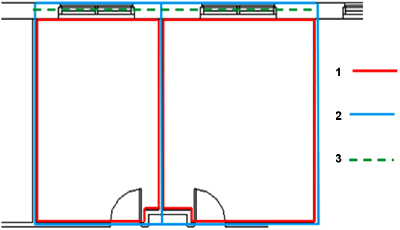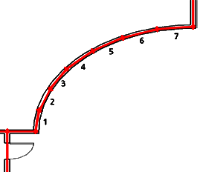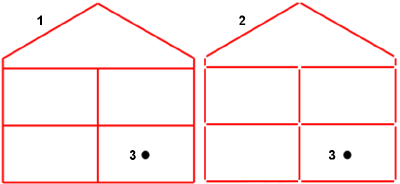In an energy model, surfaces are the paths of heat transfer to or from each space. They include surfaces between interior spaces and the external environment.
To be more accurate, they are space boundary surfaces. For simplicity, however, Revit refers to them as surfaces.
In the following illustration, surfaces separate the 5 spaces. Gaps indicate separation between the surfaces.

Surface adjacency and type
Surface adjacency and surface type are attributes that determine how each surface is processed during energy simulation.
Surface adjacency can have one of these values:
- Space: the surface is connected to another space
- None: the surface is connected to the outside environment
Surface type allows the energy simulation to differentiate surfaces based on what they represent in the model. For example, roofs, interior walls, and exterior walls have different convection coefficients.
Some surfaces are in contact with the ground. Some surfaces are transparent and transmit light and solar gain. Other surfaces are shades. During energy analysis, no heat transfer is simulated for shades; they simply obstruct direct solar radiation to other surfaces.
You can also specify a surface type as air. Use this value when a large room is organized into multiple spaces. The air represents the fictitious face that subdivides the room.
Surface geometry
In an energy model, the surface geometry represents a building's form and layout. gbXML can represent surface geometry in 2 ways: planar and rectangular.
In both cases, you must represent the overall area and position of each exterior surface relative to the sun and wind. This information ensures that the energy simulation can determine the amount of heat transfer across the surface to or from the space.
- Surface planar geometry is defined using Cartesian Point Coordinates: a series of X, Y, and Z coordinates that capture the position, shape, and size of each planar surface.
- Surface rectangular geometry captures the same information (area and position fo the surface relative to the sun and wind). However, it simply uses numerical values for height, width, tilt, and orientation.

| 1. Planar geometry | 2. Rectangular geometry |
 |
Width = 10
Height = 4 Tilt = 90 degrees Azimuth = 0 degrees |
Planar geometry is more commonly used because it represents the actual form and layout of the building with discrete planar surfaces. Rectangular geometry is more abstract, which makes it difficult to validate visually, and it cannot account for things like shading from other surfaces.
Surface planar geometry is the most common type used for whole building energy simulation.
Space and surface precision
When generating an energy model from an architectural model, there are multiple ways to place and measure spaces and surfaces. For example, the following image illustrates how some model authoring tools define space areas, volumes, and boundary surfaces in different ways, each yielding a slightly different set of measures and coordinates.
 |
|
With Energy Optimization for Revit, the automatically created energy model is typically accurate with between 0 and -3 to -5% of actual measures. This accuracy assumes appropriate settings for Analytical Space Resolution and Analytical Surface Resolution.
Another example of varying precision relates to capturing complex architectural features. In the context of an energy model, basic features like curved walls or roofs pose a challenge due to the limitation of planar surfaces. Complex building features must be accurately represented to capture the heat transfer processes effectively. For example, with a curved wall, a simple representation may capture its area adequately, but it may round solar shading effects. The following illustrations show the same curved wall represented in an energy model using 2 or 7 faceted boundary surfaces.
 |
 |
With Insight - Energy Analysis, its automated process for creating the energy model performs minimal simplification but yields greater accuracy. It works directly using the architectural building elements defined in the model. Although this method can create large gbXML processes, the cloud processing strategy minimizes this issue.
Surface edge precision
Space boundary surfaces do not need to be precisely coincident with one another. The surfaces do not need to form an airtight seal and relate precisely to the space area and the space volume. Neither the energy simulation engine nor the gbXML schema requires these airtight seals.
In fact, space area, space volume, and boundary surfaces are independent items. As a result, the surfaces can have small gaps between them or even small overlaps. This approach is important because airtight boundaries can be difficult or expensive to determine accurately. A perfectly airtight model has a negligible impact on the reliability of the energy model.
For example, this illustration shows the following:
- A model with coincident surfaces
- A model with non-coincident surfaces
- In each case, the values for space area and space volume are completely independent. So method 1 and method 2 are both acceptable as long as the space area and space volume values are accurate.
